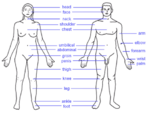Buttocks
| Buttocks | |
|---|---|
 |
|
| Male human buttocks. | |
 |
|
| Female human buttocks | |
| Artery | superior gluteal artery, inferior gluteal artery |
| Nerve | superior gluteal nerve, inferior gluteal nerve, cluneal nerves |
| MeSH | Buttocks |
The buttocks (singular: buttock) are rounded portions of the anatomy located on the posterior of the pelvic region of the apes, including humans and many other bipeds or quadrupeds.
Contents |
Anatomy

The buttocks are formed by the masses of the gluteal muscles or 'glutes' (the gluteus maximus and the gluteus medius) superimposed by a layer of fat. The superior aspect of the buttock ends at the iliac crest, and the lower aspect is outlined by the horizontal gluteal crease. The gluteus maximus has two insertion points: 1/3 superior portion of the linea aspera of the femur, and the superior portion of the iliotibial tractus. The masses of the gluteus maximus muscle are separated by an intermediate gluteal cleft or "crack" in which the anus is situated.
The buttocks allow primates to sit upright without needing to rest their weight on their feet as four-legged animals do. Females of certain species of baboon have red buttocks that "blush" to attract males. In the case of humans, females tend to have wider and thicker buttocks due to higher subcutaneous fat and wider hips.
Some baboons and all gibbons, though otherwise fur-covered, have characteristic naked callosities on their buttocks. While human children generally have smooth buttocks, mature males and females have varying degrees of hair growth, as on other parts of their body. Females generally have hair growth in the gluteal cleft (particularly around the anus), often extending laterally onto the lower aspect of the cheeks. In addition to such areas, males often have hair growth over the most (or the entirety of) the buttocks.
Connotations
The English word of Greek origin "callipygian" indicates someone who has beautiful buttocks. However, the qualities that make buttocks "beautiful" or "well-formed" are not fixed, as sexual aesthetics of the buttocks vary considerably from culture to culture, from one period of fashion to another and even from person to person.
In ancient astrology, various parts of the body were associated with signs of the zodiac - e.g. the buttocks to the Balance. Depending on the context, exposure of the buttocks in non-intimate situations often causes feelings of shame, embarrassment or humiliation in a non-exhibitionist subject, and embarrassment or amusement in a non-voyeurist audience (see "pantsing"). Expressions such as being "caught with one's pants/ trousers down" or more explicitly in Dutch, "met de billen bloot" ("with bared buttocks"), use the image as a metaphor for non-physical embarrassment as well.

Willfully exposing one's own bare buttocks as a protest, a provocation, or just for fun (especially but not exclusively practiced by youngsters such as North American frat boys) is called "mooning".
A "wedgie" is pulling someone's undergarments or swimming trunks up through their buttock "crack" to be hauled over the top of the victim's trousers, sometimes partially baring the victim's buttocks.
It is no coincidence that the English verb to spank is the only one specifically meant for physical discipline of a specific part of the body, and various other languages have terms specifically referring to spanking; in many punitive traditions, the buttocks are the preferential target for painful lessons, from educational to judicial, as offering them for punishment (especially divested) adds a psychological dose of embarrassment and even sexual humiliation to the pain, which can be meted out with less risk of long-term corporal harm than elsewhere. There are, in various cultural traditions, expressions like "seat of learning" which refer to the preferential paining of the posterior in a submissively bent and exposed position.
Many comedians, writers and others rely on the buttocks in these and other ways (such as flatulence and toilet humor) as a source of amusement, camaraderie and fun, despite (or in some cases for the sake of) the risk of being in dubious taste, if not censored.
Because in most cultures the buttocks are rarely shown naked, they are generally considered unsuitable for ornamental body markings and body modification, but may be preferential for discreet markings, such as secretive membership proof or to be shown in intimate company (e.g. amongst lovers).
In American English, phrases use the buttocks or synonyms (especially butt and arse/ass) as a pars pro toto for a whole person, but generally with a negative connotation. For example, terminating an employee may be described as "firing his ass". One might say "move your ass" or "haul ass" (or the polite, understood euphemisms "move it" or "haul it") as an exhortation to greater haste or urgency. Expressed as a function of punishment, defeat or assault becomes "kicking one's ass". Such phrases also may suggest a person's characteristics, e.g. difficult people are termed "hard asses" (polite euphemism: "hard nosed"). People deemed excessively puritanical or proper may be termed "tight asses" (in Australia and New Zealand, "tight ass" refers to someone who is excessively miserly). An annoying person or any source of frustration may be termed "a pain in the ass" (euphemism: "a pain in the neck", though some claim that this alleged euphemism actually appeared in English earlier than the former).
Certain physical dispositions of the buttocks — particularly size — are sometimes identified, controversially, as a racial characteristic (see race). The most famous intersection of racism and buttocks may be the case of Saartjie Baartman, the so-called Hottentot Venus.
Synonyms
The anatomical Latin name for the buttocks is nates (pronounced /ˈneɪtiːz/ or NEY-teez[1] in English), which is plural; the singular, natis (buttock), is rarely used. As buttocks are an object of both shame and fascination, it is not surprising that there are many colloquial terms, euphemistic, ironic or other, to refer to them. These include the following:
- backside, posterior, behind and its derivates (hind-quarters, hinder or the childish homophone heinie, strictly the whole body behind the hind leg-trunk attachment), rear or rear-end, derrière (French for "behind") - all strictly positional descriptions, as the inaccurate use of rump (as in 'rump roast', after a 'hot' spanking), thighs, upper legs; analogous are:
- aft, stern and poop, naval in origin; in nautical jargon, buttocks also designates the aftermost portion of a hull above the water line and in front of the rudder, merging with the run below the water line
- caboose, originally a ship's galley in wooden cabin on deck; also the "rear end" car of a freight train, considered a cute synonym suitable for any audience
 Nude cyclists with painted buttocks
Nude cyclists with painted buttocks - bottom (and the shortening "bot" as well as childish diminutives "bottie" or "botty"), but the use of similar-sounding booty (slang for the female body since the 1920s) as famously by K.C. and the Sunshine Band's Shake Your Booty, is an 'artistic liberty'; equivalents in other languages include the Latino culo from Latin culus, 'bottom'
- tail (strictly anatomically a zoomorphism, humans only have a tail-bone, yet the illogical tail feather was popularized by musicians; also used for the even more sensual phallus) and tail-end
- Tush or tushy (from the Yiddish language "tuchis" or "tochis" meaning "under" or "beneath")
- Dumper sometimes denotates the buttocks, especially when talking about a large butt.
- trunk, in American English, particularly when describing large buttocks "junk in the trunk". This usage refers metaphorically to an automobile's trunk.
- arse or ass, asshole, and (butt-)hole - a pars pro toto (strictly only the actual body cavity and directly adjoining anal region); also used as an insult for a person. The term is Anglo-Saxon dialect, and therefore dates back over a thousand years.
- badonkadonk - onomatopoeic slang meaning the voluptuously bouncing, large yet firm buttocks of a woman
- breech, a metaphorical sense derived from on older form of the garment breeches (as the French culotte meaning pantoloons, via cul from Latin culus 'butt'), so 'bare breech' means without breeches, i.e. trouserless butt
- bum - in British English, used frequently in the United Kingdom, Ireland, Canada, Australia, New Zealand and many other English speaking Commonwealth countries, also historically in U.S., is a mild often humorous reference to buttocks, not necessarily in vulgar or sexual context: "I've a boil on my bum, thrice as large as my thumb" - The Judge With The Sore Rump, St. George Tucker. Also used in reference to anal intercourse, often as an insult, as in bum boy (for a homosexual). Also a verb - to practise anal intercourse.
- buns, mounds (cfr. Butte, a geographical mound, known since 1805 in American English, from (Old) French butte "mound, knoll") and orbs - shape-metaphors.
- bund - derived from Punjabi
- bunda - bottom, of Brazilian Portuguese origin.
- butt - the common term for a pair of buttocks (singular, as one body-part; cognate but neither its root nor an abbreviation) in the US, used in everyday speech. It is also acceptable in print.
- can (a container) had an unusual development: the slang meaning "toilet" is recorded circa 1900, said to be a shortening of piss-can, the meaning "buttocks" from c. 1910, verb meaning "fire an employee" (to flush=dump?) from 1905.
- cheeks, a shape-metaphor within human anatomy, but also used in the singular: left cheek and right cheek; sounds particularly naughty because of the homonym and the adjective cheeky, lending themselves to word puns
- culo - (From Spanish/Italian/) slang, usually meaning a woman's voluptuous, round and firm buttocks. Put simply the Latino equivalent of booty, although in Spanish it is considered vulgar and offensive (but less so in Spain than in Latin America).
fanny - a socially acceptable term in print, in the United States at least, for many years before some of the bolder terms came along; and a subject of jokes, since "Fannie" can be a woman's name, diminutive of "Frances"; however, in British English fanny refers to the female genitals or vulva and is considered vulgar. The figure of a bare-bottomed lass named Fanny is ubiquitous in Provence (the southeast of France) wherever pétanque is played: traditionally when a player loses 13 to 0 it is said that “il est fanny” (he's fanny), and he has to kiss the bottom of a girl called Fanny; as there is rarely an obliging Fanny, there is always a substitute picture, woodcarving or pottery so that Fanny’s bottom is always available.[2]
- fourth point of contact: in military slang, because of the sequence of textbook parachute jump landing
- fundament (literally "foundation", not common in this general sense in English, but for the butt since 1297)
- Gand or Gaand - a Hindi derivate
- hams, like buttocks generally as a plural, after the meat cut from the analogous part of a hog ; pressed ham refers to mooning against a window; brawn, a singular derived from the Frankish for ham or roast, is also used for both a muscular body part (but either on arms or legs) or boar meat, especially roast
- hurdies - British, origin unknown, also applied to the whole rump
- moneymaker, a term coming from exotic dancers and other entertainers who use their buttocks (even clothed) to earn money; usually referencing to females.
- moon was a common shape-metaphor for the butt in English since 1756, and the verb to moon meant 'to expose to (moon)light' since 1601, long before they were combined in US student slang in the verb (al expression) mooning "to flash the buttocks" in 1968.
- prat (British English, origin unknown; as in pratfall, a vaudeville term; also a term of abuse for a person)
- seat (of the trousers; or metaphorically) another long-standing socially acceptable term, referring to the use for sitting - but compare the sarcastic use of seat of wisdom and similar expressions, such as 'seat of learning', referring to use as target for an 'educational' spanking.
- sit-upon; has various independent counterparts in other languages, e.g. Dutch zitvlak ('sitting plain'), German Gesäß (~=guh|seys), Italian sedere
- six; in military terminology, particularly in the U.S. Navy, it refers to the term "six o'clock", i. e. a point directly behind the referenced person.
- ultimatum (Latin, literally 'the outer-most') was used in slang c.1820s.
- For more slang terms for the buttocks, see WikiSaurus:buttocks — the WikiSaurus list of synonyms and slang words for buttocks in many languages.
- For unrelated homophones of butt(ocks), see also butt (disambiguation) and bud (disambiguation)
Related terms

- The word "callipygian" is sometimes used to describe someone with notably attractive buttocks. The term comes from the Greek kallipygos, (first used for the Venus Kallipygos) which literally means "beautiful buttocks"; the prefix is also a root of "calligraphy" ("beautiful writing") and "calliope" ("beautiful voice"); callimammapygian means having both beautiful breasts and - buttocks.
- Both the English (in) tails and the Dutch billentikker ('tapping the buttocks') are ironic terms for very formal coats with a significantly longer tail end as part of festive (especially wedding party) dress
- macropygia means 'heaving large buttocks, hindquarter', and occurs in biological species names,
- a pygopag(ous) (from the Greek pygè 'buttock' and pagein 'attached') was a monster in Ancient (Greek) mythology consisting of two bodies joint by common buttocks, now a medical term for 'Siamese' twins thus joint back-to-back
- pygophilia is sexual arousal or excitement caused by seeing, playing with or touching the woman's buttocks; people who have strong attraction to buttocks are called pygophilists.
- pygoscopia means observing someone's rear; pygoscopophobia a pathological fear to be its unwilling object
- pygalgia is soreness in the buttocks, i.e. a pain in the rump.
- Steatopygia is a marked accumulation of fat in and around the buttocks.
- uropygial in ornithology mean, situated on, belonging to, the uropygium, i.e. the rump of a bird
- "bubble butt" has at least two connotations, which are at odds with each other: either a small, round and firm pair of buttocks resembling a pair of soap bubbles next to each other, or a large rear end, seemingly about to burst from the strain. In both cases, the term implies an appealing shapeliness about the buttocks.
Fashion
Because many cultures have a (partial) nudity taboo, which usually applies specifically to the buttocks (as usually to the most erogenous zones), mainstream garments generally cover the buttocks completely, even when it is not a practical requirement. Nevertheless male and female clothing is often designed in a way that reveals the shape of the buttocks under the clothing.
Some articles of clothing are designed to expose the buttocks. Such clothing is not generally worn in public situations; however, it is considered appropriate to wear such clothing at swimming facilities or at the beach.
Emphasis on one part or another of the body tends to shift with generations. The 1880s were well-known for the fashion trend among women called the bustle, which made even the smallest buttocks seemingly huge. The popularity of this fashion is shown in the famous Georges Seurat painting Sunday Afternoon on the Island of La Grande Jatte in the two women to the far left and right. Like long underwear with the ubiquitous 'butt flap' (used to allow baring only the bottom with a simple gesture, as for hygiene), this clothing style was acknowledged in popular media such as cartoons and comics for generations afterward.
More recently, the cleavage of the buttocks could be exposed by some women as fashion dictated trousers be worn lower. (known as a "coin slot", or "vertical smile").
An example of another attitude in an otherwise hardly exhibitionist culture is the Japanese fundoshi.
See also
- Bollocks
- Spanking
- Buttock augmentation
- Coccyx
- Gluteus Maximus
- Gluteal cleft
- Hip and buttock padding
- Waist-Hip Ratio
Sources and references
- Etymology on line one can also search for most synonyms
- For synonyms: On-line thesaurus
- This article incorporates text from the public-domain Catholic Encyclopedia of 1913. passim
External links
- "The Muscles and Fasciæ of the Thigh" (by Henry Gray) at "Anatomy of the Human Body", 1918.
|
|||||||||||||||||||
|
||||||||||||||


